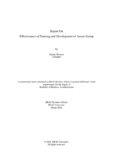Effectiveness of training and development of Ascent Group

View/
Date
2020-03Publisher
BRAC UniversityAuthor
Mostafa, KarinaMetadata
Show full item recordAbstract
This report was written for the fulfillment of my Internship Program with BRAC Business
School. I completed my internship with Ascent Group, specifically with the Training and
Development team of Ascent group, as an Operations Intern.
The objective of this study is to measure the Effectiveness of the Training and Development
Process of Ascent Group. The model used to measure such was Kirkpatrick’s model. The
methods used to collect data for this study were Observation, Unstructured interview taken
through telephone of an Academic Supervisor of Scholastica and prior lecturer of SPEED,
Active Participation and secondary data found through the internet.
Training and Development is the process of acquiring the knowledge, skills and attitude that
increases competencies. It has been proven that Training and development is more beneficial
to companies than it is to employees, since competent employees equal to more effective and
efficient performance. Ascent Group places heavy emphasis on Training and development as
well. This practice has managed to keep Scholastica relevant and maintain its reputation in
the market for over 40 years.
During my internship, I learned that SPEED, the Training and Development team of Ascent
Group, uses a combination of feedback forms and tests taken at different stages to determine
the effectiveness of their training. These data from the feedback forms are later input as
organized information, and are used to evaluate where they need improvement.
According to the information I was able to collect from the HR department of Ascent Group,
and my own personal observation, the overall results from the first three stages of the
Kirkpatrick’s model are positive. The results show that trainees in average all enjoy the
training sessions, learn from it, and are able to transfer it to their daily work and improve
their performance.
